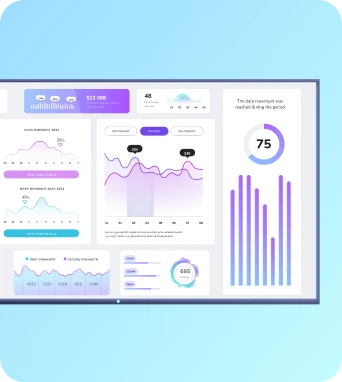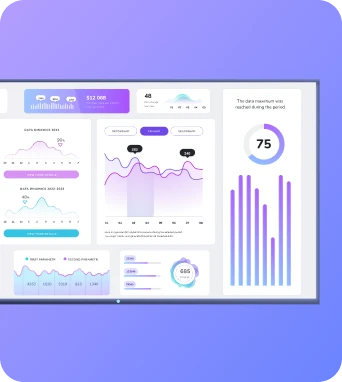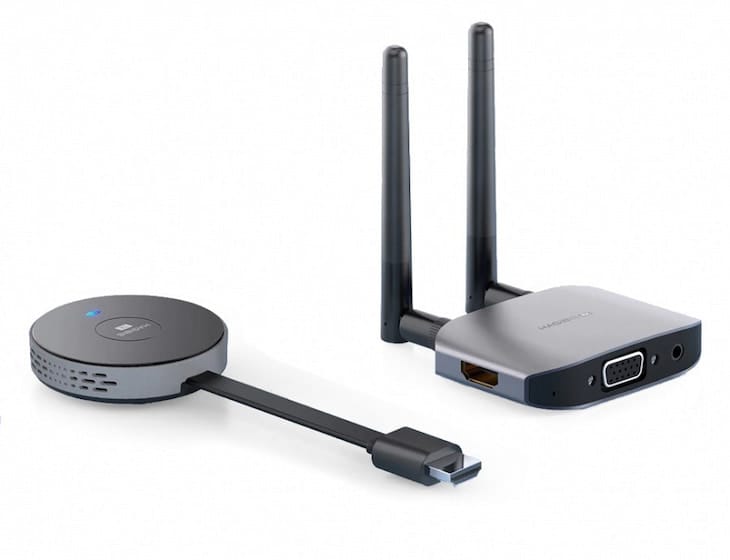Awkward corners, weird windows, and funky half-walls, oh my! With so many mysterious 'design choices' at your workplace, it just isn’t possible to get more digital signage screens installed.
But even if traditional cables won't make the cut, there are new innovations that can make your life easier. It all goes back to the wireless HDMI transmitter: the easiest way to eliminate cable clutter.
This guide covers everything you need to get started with wireless HDMI transmitters for digital signage, even if you're dealing with tight or awkward spaces. We also explain how these devices work, how they affect digital signage screens, and how to choose the best model for your business.
But first, let's address the elephant in the room:
The problem with cables in digital signage
So there's nothing inherently wrong with using cables, especially if you're working in a traditional office building.
But most of us aren't working in perfectly adapted spaces. And let's face it: we can't always mount our TV screens in the rooms or spaces that need them.
Things get even more complicated in busy environments.
For example:
- You'll need to find a way to route cables from your screen to an outlet. And if you don't have one nearby, this could be several feet of cordage (tripping hazard, anyone?).
- Alternatively, you might have limitations on where screens can be placed due to cable length. You can't very well have a 20-foot extension cord running through your hotel lobby, for example.
- Even if you are okay with these 20-foot extension cords, you'll still have to contend with aesthetic issues. It's one thing to hide bright orange cables behind your TV screen, and another to run them along the walls and corners of your business.
The point is, not every work environment has the right spacing for digital signage.
But the good news is, it's easier to fix than you think.
All you need is a wireless HDMI transmitter to send digital signage from one screen to another.
What’s a wireless HDMI transmitter?
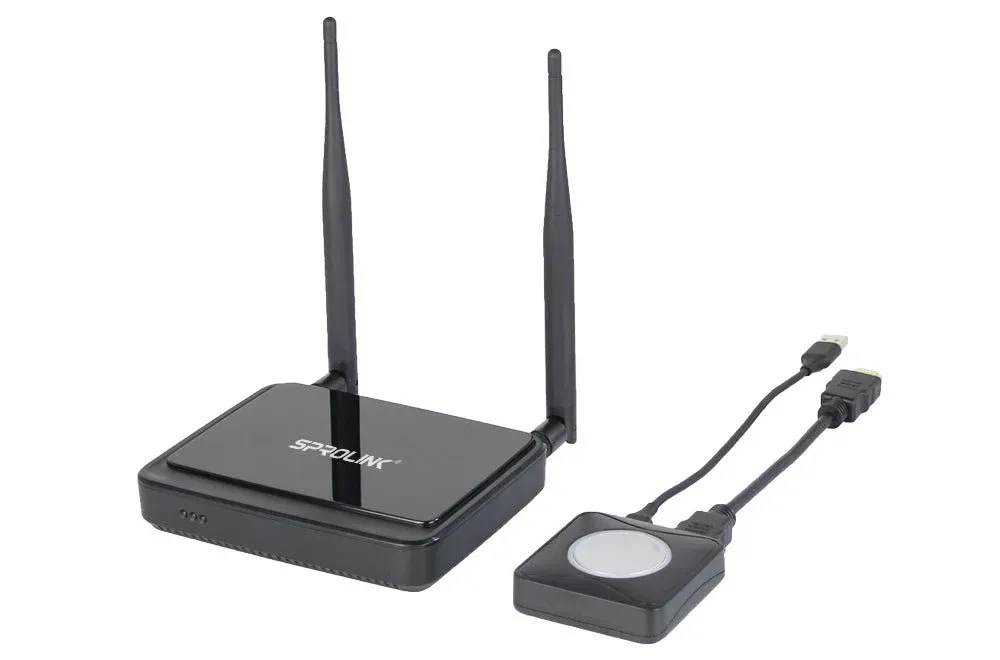
You can think of wireless HDMI transmitters as basically USB sticks for TV screens, except they use radio frequency (RF) technology to transmit high-definition signals. With them, you can easily connect your streaming devices to monitors or display screens where you want to host your content.-
There are two pieces of equipment that make this possible: the transmitter, and the receiver. These allow you to wirelessly transmit content (like a digital menu board or customer form) directly to a screen.
First, you connect the transmitter to your HDMI port. Then, you plug the receiver into your TV's HDMI input. Your HDMI device will send an interference-free transmission (i.e., microwave frequency) that your device decodes into high-def picture.
And if you're looking for a more convenient solution for setting up signage without messy cables,
Why use a wireless HDMI transmitter in digital signage setups?
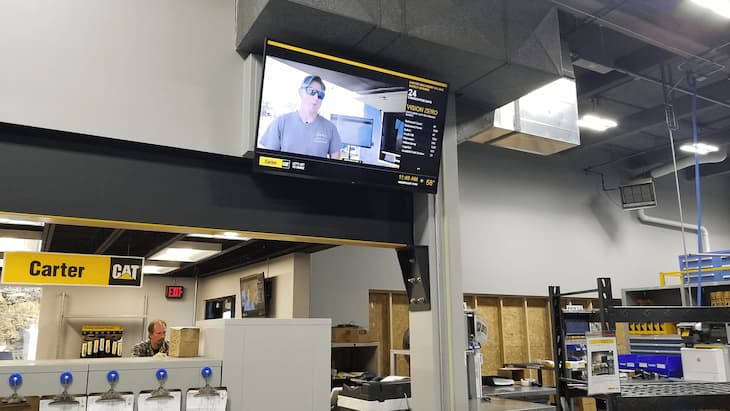
There are so many reasons to choose HDMI transmitters over traditional cables — and it's not just because they're more convenient (although that's definitely part of it).
You can also use your wireless HDMI transmitter to:
Create a cable-free setup
Messy, visible cables are usually a given in awkward spaces, especially when dealing with high-mounted screens, screens in tight corners, or distant displays.
All that changes with a wireless HDMI transmitter. A single device can free up oodles of space and eliminate your need for excess cables.
Be flexible in display placement
Since you don't have to worry about bulky attachment plugs, you can position screens anywhere — including difficult or awkward spaces.
You're also no longer tied down by a WiFi connection. With a wireless transmitter and a reliable receiver, you have the flexibility to stream all kinds of digital signage content. Plus, you can place your media player right next to an Ethernet cable, giving you the speed and stability you need for live video or those big, high-quality video files without buffering.
Ease of installation
Wireless HDMI transmitters are as plug-and-play as it gets. Just connect the transmitter to your HDMI source and the receiver to your HDMI input, and you'll be ready to display digital content on your TV, computer, or projector.
Imagine the flexibility this brings—now you can set up screens anywhere in your building without worrying about running cables between your devices and displays.
Cost-effective solution for retrofits
If you're currently upgrading your digital signage, a wireless transmitter could save you hundreds of dollars (and hundreds of hours) of labor.
You could purchase multiple HDMI cables and install them yourself. Alternatively, you could purchase one wireless HDMI transmitter and multiple receivers.
As you can imagine, the latter is a cheaper and faster option in virtually every situation.
Create better aesthetics
Say goodbye to chunky orange extension cords — and hello to wireless transmitters that are no bigger than a coffee coaster.
For one thing, your display will look cleaner and more professional to viewers. It'll also be less of a tripping hazard for customers and the people on your team.
4 ways to use a wireless HDMI transmitter in awkward spaces
No matter your field, business, or industry, you’ll find a perfect use for wireless transmitters.
Just imagine the possibilities for digital signage in:
- Retail: You can easily mount screens in window displays or on high walls without cable clutter.
- Hospitality: Put screens in lobbies or the corners of restaurants, even where space is tight.
- Education: Simplify installations in classrooms or lecture halls where wiring is a challenge.
- Corporate: You'll have flexible screen placement in boardrooms or conference halls — even without needing to redesign spaces.
The same goes for manufacturing, healthcare, and beyond. If you have awkward, confusing, or limited space for signage, a wireless HDMI transmitter can help to make it possible.
Potential limitations and considerations for your wireless HDMI transmitter
As amazing as wireless HDMI transmitters are, they're not necessarily perfect.
You need to keep in mind at least these three drawbacks:
- Signal interference: Older wireless transmitters operated on 5 GHz frequency, which made it all too easy for cell phones and routers to interfere. Most modern devices minimize this by offering an adjustable frequency, but you should still ensure a stable environment before giving this a try.
- Distance limitations: Wireless HDMI typically works well within a certain range, which can be anywhere from two to 250 meters depending on the product. You should familiarize yourself with your setup's requirements before deciding on a particular device.
- Line of sight: Some digital signage setups require a clear path between transmitters and receivers (depending on the tech). For example, some devices send signals that penetrate floors and ceilings, while others need to stay close to your TV.
All that said, wireless HDMI transmitters are still a great option for most signage setups. If you do your homework and choose the right device, you’ll be well-equipped to get and stay cable-free.
Speaking of choosing the right device…
How to choose the right wireless HDMI transmitter for your setup
Ready to ditch the cable box for good?
Here's our advice on choosing the right wireless HDMI transmitter for your business:
- Range: How far away can your receiver be from your transmitter? If you don't need much distance, a cheaper transmitter might be a good bet. But if you need to broadcast a signal from 50 feet or more, you may want to shop for a more expensive device.
- Video quality support: The best wireless transmitters can handle 4K and full HD streaming support. Just keep in mind this might cost several hundred dollars or more.
- Number of displays supported: You can find several small transmitters packaged with multiple receivers on Amazon, usually to the tune of $250. If you don't need multiple receivers, however, you can save some money by shopping for a smaller package.
Taking the plunge with a wireless HDMI transmitter
Installing digital signage in challenging spaces has never been so simple. With a wireless HDMI transmitter and your TV screen of choice, it’ll take 20 minutes or less to get up and running.
It might be worth exploring wireless HDMI transmitters on your own. Curious to learn more about how Fugo can help? A few of these resources might help:


